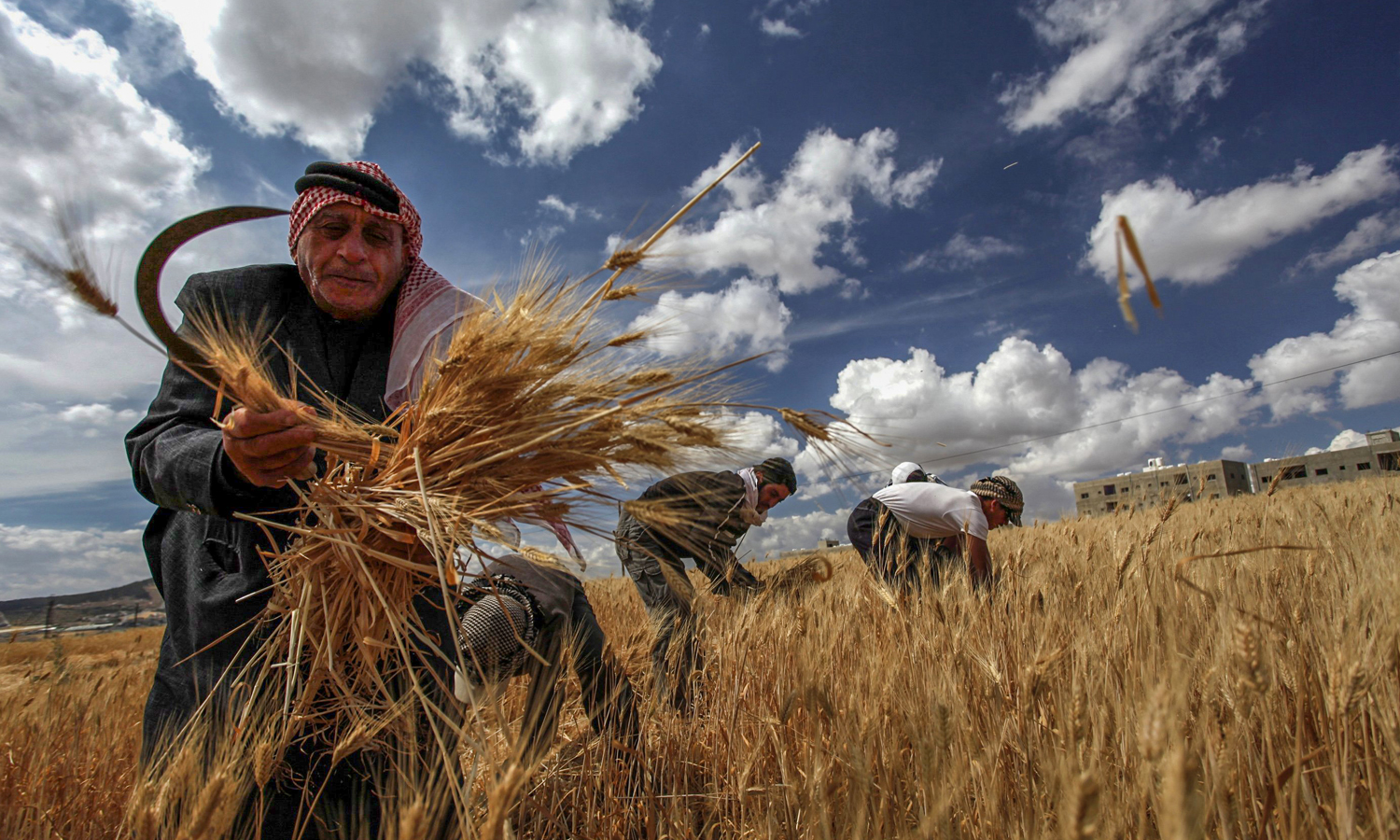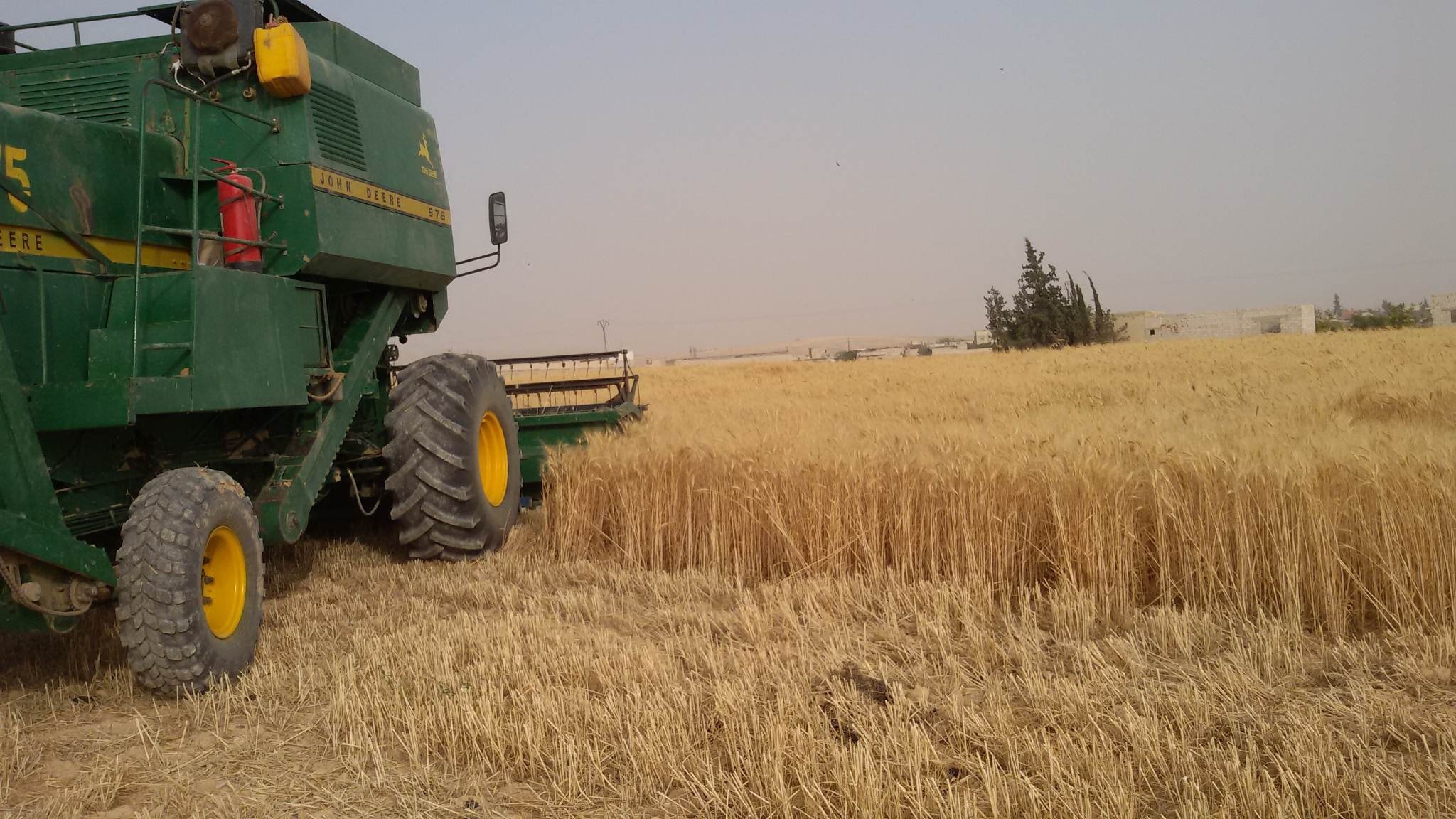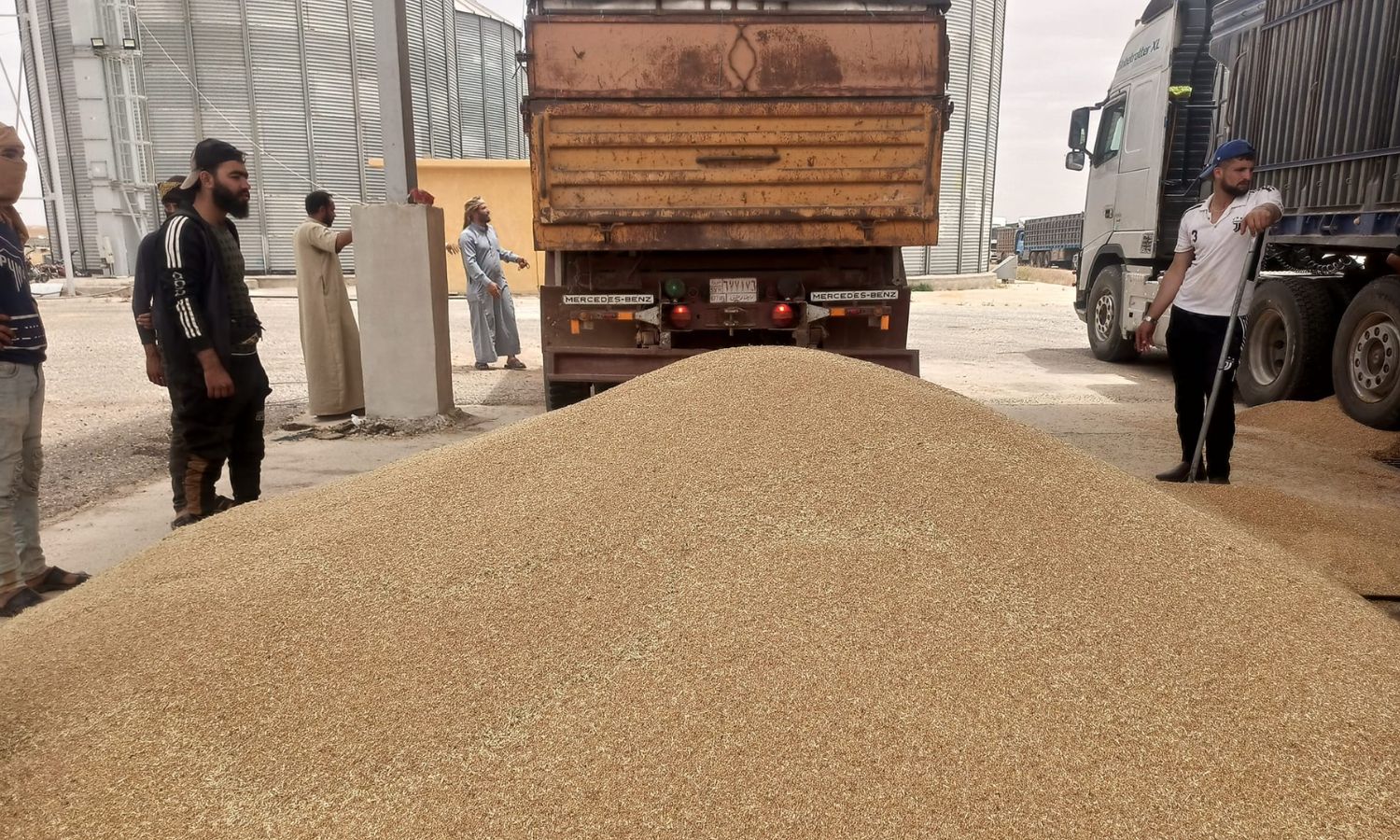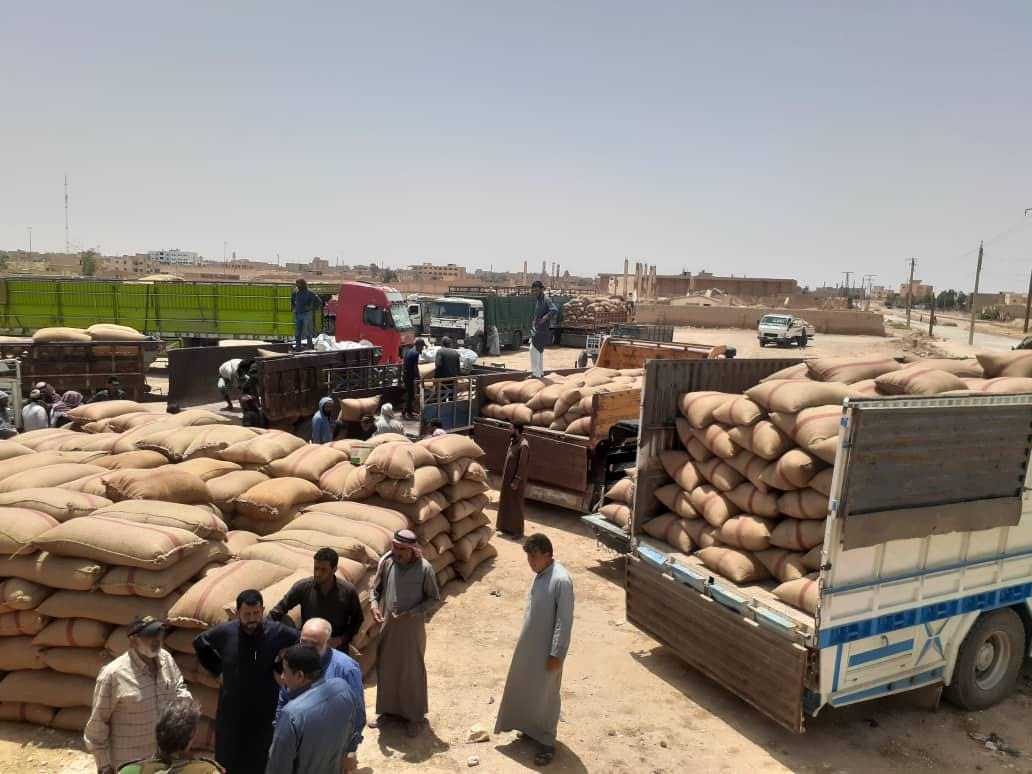



Jana al-Issa | Hassan Ibrahim
Every year, the Syrian government sets a price for wheat purchased from farmers that is not commensurate with production costs and is less than the prices usually set by the de facto authorities in north and west Syria.
This dilemma usually accompanies criticisms and demands, which are disregarded, even to encourage farmers of the most prominent strategic crop in Syria before 2011 to continue.
The decrease in government support during the stage of planting and harvesting wheat in the areas controlled by the regime, in addition to setting a price that is not commensurate with the costs, forces farmers every year to sell their crops outside the regime areas, where the selling price is higher.
This creates a parallel market for the material, in addition to the reluctance of some farmers to grow wheat in the coming seasons and their orientation towards other crops and cultivations with better returns.
In return for the regime’s lack of interest in the strategic crop in terms of subsidies during the stages of planting, harvesting, and then selling, the government attaches importance to importing the material from the “Russian ally” through several methods to make up for the shortage every year.
In this file, Enab Baladi tries to explain the government’s handling of the most important agricultural crop in Syria and its effects on farmers and citizens while raising questions about the reasons for replacing that with wheat from Russia and the nature of what is offered in exchange for Russian wheat.
On April 18, the Syrian government set the price of purchasing a kilogram of wheat from farmers this year at 2,300 Syrian pounds, equivalent to less than ($0.3). It described the price as “encouraging” despite the fact that its value was less than what it set in 2022 ($0.5), and at that time, it was equivalent to about 2,000 Syrian pounds.
According to the regime’s Prime Ministry, these prices were set after an “accurate calculation” of the cost of production in light of the support provided to the agricultural sector in terms of seeds, fuel, and fertilizers, and a profit margin for the farmer of 35% per kilogram.
Following sharp criticism that the price is not commensurate with the costs, the economic committee in the regime’s government raised the purchase price of the material about three weeks after the first decision and set the price per kilogram at 2,500 Syrian pounds, to which an amount of 300 SYP is added as “encouraging incentives,” bringing the final price to 2800 SYP per kilo.
Despite the price hike, most farmers still consider that it does not reach the minimum farming expenses, amid the 100% increase in harvest costs this year, in addition to the high production costs of securing seeds, fuel, irrigation, and others.

Harvesting the wheat crop in al-Dumayr region, east of Damascus – May 25, 2023 (Facebook/General Union of Peasants)
The former director general of the Union of Syrian Agricultural Chambers, Samer Kaakarli, told Enab Baladi that the pricing mechanism for strategic crops such as wheat, cotton, and previously barley since Hafez al-Assad assumed power until 2005, was considered the responsibility of the Costs Department in the Agricultural Economics Directorate of the Ministry of Agriculture.
In determining the price, the Costs Department relies on the costs of cultivating one dunam of wheat, including the costs of sowing, fertilizers, pesticides, fuel, harvest wages, etc., in addition to the land revenue. However, some farmers may resort to leasing lands to grow the crop.
The Costs Department submits the results of its study to the Supreme Agricultural Council, which in turn increases it by 25% over the proposed price per kilo.
After 2005, Bashar al-Assad began directing his government towards a social market economy to reduce spending costs in a number of sectors, including the wheat season, according to Kaakarli.
The agricultural engineer pointed out that the regime’s Republican Palace began to interfere in the mechanism of pricing costs and to reduce them to unreal levels. For example, land rent is no longer a criterion for determining the price, which affects the purchase price from farmers.
Kaakarli attributed setting the price of wheat at less than the value of real costs this season to reducing expenditures in general due to the decrease in cash liquidity.
For his part, economic researcher Zaki Mahshi explained the regime’s handling of the wheat file by betting on the inability of farmers to sell outside the areas under its control, guaranteeing the sale of their crops to the official authorities responsible for receiving the crop and betting on the weakness of sales mechanisms in other areas of control.
The regions of northeastern Syria suffer from the issue of wheat marketing, the long waiting, and discrimination between farmers, and therefore the regime exploits the farmers in those areas to buy their crops through brokers, according to Mahshi.
The regime does not have enough liquidity to cover the real costs of wheat production with a profit margin for the farmer, according to the researcher.
He considered that this forced the regime to set a price that was considered acceptable in terms of covering costs for some farmers only, as the fixed price might not cover the costs of some farmers’ seasons, especially those who relied in agriculture on larger quantities of fuel, fertilizers, and seeds from the black market.
According to the economic researcher, the regime is interested in achieving a balance between the different societal groups, including the peasants, in order to avoid any future social unrest that might affect the fragile stability that currently exists.
While the professor of agricultural economics at al-Zaytouna International University, Salim al-Nabulsi, believes that the Syrian regime has no mind regarding the wheat file.
“Those who run the scene today are personalities close to the regime that does not look at people’s interests, and therefore the regime is not currently concerned with strategic crops, the existence of food stocks, and so on,” he added.
Al-Nabulsi told Enab Baladi that the regime follows a policy of abandoning the central state policies, especially with regard to economic issues, and therefore it will move from the stage of the centralized economy and the socialist slogans with which it is known to the stage of the open market system, supply and demand, and all the tools of the capitalist system.
This means a gradual withdrawal from the central state’s role in supporting farmers and strategic crops, to the state’s role as observer and legislator only, according to the expert in agricultural economics.

Delivery of the wheat crop from the farmers to the Grain Center in the northeastern city of Raqqa – May 31, 2023 (Facebook/Agricultural Media in Syria)
“Climate change, a faltering economy, and residual security issues have decimated Syria’s 2022 grain crop, leaving the majority of its farmers in a precarious position, the United Nations Food and Agriculture Organization (FAO) said in September 2022.
Syria’s 2022 wheat harvest amounted to around 1 million tons, down some 75% from pre-crisis volumes, while barley was almost non-existent, Mike Robson, FAO’s Syria Representative told Reuters.
“Climate change isn’t easy anyway, but it is doubly not easy in a place like Syria with high inflation, no power, no good quality inputs, and some residual security issues that are still playing up in parts of the country,” Robson said.
Because of Western sanctions, the regime government is experiencing difficulties in obtaining wheat from the international market, and although food shipments are not subject to Western sanctions, banking restrictions and asset freezes have made most commercial companies avoid dealing with the regime, which prompts a single solution to import from Russia, its most important ally.
For years, the government of the regime has been providing wheat from Russia in various ways and methods, including through bilateral agreements whose details are rarely disclosed, or through tenders put forward by the state’s Public Establishment for Grain to buy wheat, or what quantities Russia sends and calls “aid,” or Moscow’s “theft” of Ukrainian wheat and sending part of it to Syria, according to what Ukrainian figures and news agencies have revealed, despite the regime’s denials.
Russia is the largest wheat exporter in the world, with expectations of abundant yields and the arrival of the wheat crop in Russia to 78 million tons in 2023, including the areas it took control of after its invasion of Ukraine, according to what was stated by the Russian Minister of Agriculture, Dmitry Patrushev, during his meeting via video with Russian President Vladimir Putin in April.
Most of the details of the regime’s import of wheat from Russia are absent, and it announces through official statements that the import of wheat is from “friendly” Russia. Media outlets previously revealed leaks of some contracts.
These agreements included talks by officials of the regime’s government about changing the destination (Russia) and searching for an alternative, but it was within the framework of the attempt without seeing the light.
In January 2022, the President of the Ukrainian Crimean peninsula (which Russia annexed from Ukraine since 2014), Sergey Aksionov, announced the signing of agreements with the government of the Syrian regime, stating that Crimean farmers will supply Syria with up to two million tons of wheat annually, adding that the government of the regime is “ready to buy wheat.”
Abdulatif al-Amin, the General Director of the General Establishment for Cereal Processing and Trade (Hoboob), announced two months after Aksionov’s statement that it intends to contract the supply of 200,000 tons of wheat from India and that it is also looking for alternative options for Russia to import wheat, due to only an increase in its prices, pointing out that Russia’s decision to ban the export of wheat at the time does not apply to Syria.
Al-Amin stated to the government Tishreen newspaper in March 2022 that the costs of importing one ton of wheat rose from $317 to $400 after raising the insurance value. However, the old contracts from Russia (300,000 tons) are supplied gradually and at the old price.
After that, there was no talk of the arrival of any quantities of wheat from India until al-Amin said in July 2022 that Hoboob had concluded contracts to import wheat “almost enough” until the start of the 2023 season.
Hoboob’s director explained that compensating for the shortage of wheat is done by importing it from Russia and the Black Sea countries and that when needed, the corporation concludes barter contracts to import flour instead of bran as an emergency solution, according to his interview with the local newspaper, al-Watan.
Fifteen days after al-Amin’s statements, the regime’s government agreed to grant Hoboob a financial loan of 100 billion Syrian pounds, with the aim of “financing the purchase of the wheat season for the year 2022, to enhance the strategic stock of the material.”
In October 2022, the former Minister of Internal Trade and Consumer Protection, Amr Salem, revealed the existence of discussions to contract the supply of Russian wheat to the regions of Syria and said that there is the implementation of contracts signed with 600,000 tons, respectively, and that a million tons of Russian wheat have been contracted to be received successively, pointing out that it suffices the need until June 2023.
Salem mentioned, according to Tishreen newspaper, that discussions are taking place with Russian companies in order to market surplus products and to study the possibility of exporting some Syrian materials and crops to reduce the wheat bill, such as citrus and olive oil.
Talk about exchanging citrus fruits for Russian wheat is renewed with each agreement, but the exchange process raises doubts given that it is not always successful, and neither the regime government nor Russia has disclosed whether the export of these products to Russia is in exchange for wheat from Moscow.
On February 27, the Ministry of Internal Trade announced the export of the first batch of blood oranges to Russia, amounting to 250 tons, by extracting them directly from farmers and sorting and packing them in their centers in the coastal region.
Ziyad Hazaa, Director General of the Syrian Trade Corporation, said that there are other types of citrus that will be exported, pointing out that the current agreement is to export the quantities of the first phase, i.e., about 1000 tons, but the containers that were received contain 250 tons of oranges, and it is likely that the direction will be for the export of vegetables and other agricultural materials, according to al-Watan newspaper.
Over the past years, the Syrian regime has sought, through intermittent periods, to obtain wheat by issuing tenders by the state’s grain buyer, Hoboob, in which internal-external price offers are announced for a “consensual” contract to import a specific amount of wheat per ton.
Hoboob sets conditions and criteria for each tender, including determining insurances for each ton offered and the period for shipping the quantity, with the bidder specifying the origin and source of the goods by presenting it according to what is permitted and submitting the offer in the US dollars.
Most of the tenders specify the destination for importing wheat from Russia, including Romania and Bulgaria, and rarely head towards the EU countries, such as those offered by the regime’s government on August 12, 2020, to buy 200,000 tons of wheat from the European Union and the Black Sea region.
Russia sent wheat to Syria as humanitarian aid from a “friendly and ally” country before its military intervention in Syria in 2015, and quantities of the crop continued to arrive after that, including 100,000 tons as aid in March 2015 and 50,000 tons in August 2016 and beyond.
In August 2016, Reuters, quoting an unnamed Syrian government source, said that Syria had not yet received any Russian wheat under commercial agreements signed by the General Establishment for Cereal Processing and Trade (Hoboob), despite the signing of two agreements with the Russian authorities to import wheat.
Russian Foreign Minister Sergey Lavrov said in December 2020 that Russia had provided 100,000 tons of wheat to Syria during the same year and plans more shipments as part of humanitarian aid.
Anton Mardasov, a non-resident scholar at the Middle East Institute, told Enab Baladi that Russia used to provide Syria with wheat for free at its own expense before it intervened militarily, but after that, the two parties turned to contracts.
The MEI’s Syria program fellow said that the Russian side, after its military intervention, changed supply plans several times due to the sanctions.
Mardasov gave an example that a southern Russian company supplied Syria with wheat and corn on paper, but in reality, it did not participate in the supply process at all, and the Russian side did not disclose the suppliers because of the sanctions, and the details of wheat exports are confidential.
For his part, the agricultural engineer, Samer Kaakarli, said that the file of wheat contracts is related to politics more than being economical and that it is issued by the Syrian Republican Palace, and that there are businessmen (wheat mafias) close to it, who have a great interest in the lack of wheat in order to earn commissions, pointing to the regime risking the crop for the benefit of the “wheat mafias.”
Four months after Russia invaded Ukraine, the Ukrainian embassy in Beirut said in June 2022 that Russia has sent its ally Syria an estimated 100,000 tons of wheat stolen from Ukraine since invading the country, describing the shipments as “criminal activity.”
In a statement to Reuters, the embassy said the shipments included one aboard the Matros Pozynich, a Russian-flagged vessel that docked at Syria’s main seaport Latakia in late May.
Data from Refinitiv ship tracking data showed the Matros Pozynich loading wheat at the port of Sevastopol in Crimea – annexed by Russia from Ukraine in 2014 – with a May 19 departure date and the discharge location given as Syria.
Wheat sent to Syria from the Black Sea port of Sevastopol in Crimea increased 17-fold this year to just over 500,000 tons, previously unreported Refinitiv shipping data shows, to make up nearly a third of the country’s total imports of the grain, Reuters reported on December 19, 2022.
Reports about receiving stolen wheat from Ukraine were denied by the Syrian regime’s ambassador to Russia, Riyad Haddad, who said that Syria had not received Ukrainian wheat and that the shipments come from Russia under long-term contracts that were signed before the start of the Russian “military operation” in Ukraine. He considered that talking about stolen wheat was a “media fabrication.”

Delivery of the wheat crop from the farmers to the Grain Center in the northeastern city of Raqqa – May 31, 2023 (Facebook/Agricultural Media in Syria)
The Syrian regime is resorting to various methods to obtain the strategic crop from Russia at a time when other options may be available to obtain the material locally, such as raising the purchase price of wheat from merchants, which prevents the creation of a parallel market, as well as perhaps motivating merchants in different areas of control to sell the crop to whoever pays the highest price.
The regime does not feel much pressure in the wheat file because of its ability to import it at preferential prices from Russia as a result of its control over Ukrainian wheat and the controls that Moscow put in place to sell wheat to global markets, according to economic researcher Zaki Mahshi.
Mahshi said that although importing wheat increases the burdens of the state’s general budget, it further strengthens relations with Russia, in addition to that the import to Syria is carried out by men affiliated with the regime who are looking for gains through a profit margin from this trade.
This, in turn, achieves a kind of balance of power that the regime wants, with affiliate businessmen on the one hand and external allies on the other.
Political economist Dr. Joseph Daher believes that the reason for the Syrian regime’s sacrifice of quantities of the local strategic wheat crop at the expense of Russian wheat is a combination between the lack of financial capabilities and the state’s capabilities to support agriculture (through access and provision of fertilizers, energy resources, and electricity).
Also, because of the general desire to promote the commercial sector, where there are many new businessmen associated with the Syrian regime.
In an interview with Enab Baladi, Daher considered that the multiplicity of ways to obtain wheat from Russia is probably due to the fact that the Syrian regime is unable to buy such amounts due to the lack of financial reserves and foreign currencies.

Delivery of the wheat crop from the farmers to the Grain Center in al-Bukamal town in the eastern Deir Ezzor governorate – May 25, 2023 (Facebook/The Agricultural Association in al-Bukamal)
The head of the regime’s Marketing and Processing Office in the Peasants Union, Ahmad al-Khalaf, warned on April 20 of the creation of the imposed low price of wheat “a parallel market with higher prices than the specified price,” which may lead to the reluctance of farmers in the next season to plant this strategic crop and to turn to crops that provide better income for them.
The first government pricing, before the amendment, did not take into account the costs of production and living for farmers and their families, such as transportation, food, education for their children, and others, according to al-Khalaf.
He pointed out that the current price of a kilo of bulgur in the market reaches 7,000 SYP, and one kilo of Freekeh (unripened wheat) reaches 20,000 SYP, and they are two wheat products.
Salim al-Nabulsi, a professor in agricultural economics at al-Zaytouna International University, told Enab Baladi that the lack of sufficient wheat stocks will require the state to import, which in turn exhausts its treasury. Thus, the regime will resort to compensating for losses by raising the prices of bread and reducing allocations of subsidized bread.
Regarding the impact of the regime’s policy on the wheat file on the farmers of the crop, al-Nabulsi explained that the farmer will continue his agricultural work, and he is concerned that at the end of any crop, regardless of its type, he will receive funds that cover his costs and achieve a margin of profit that enables him to live a decent life.
The farmer at the individual level is not interested in strategic issues, so he will resort to abandoning wheat cultivation if the economics of the crop cause him losses, or at least do not cover the costs, and instead, he will grow other crops that bring him a good economic return, according to al-Nabulsi.
At the end of December 2022, the head of the Professional Federation of Food and Agricultural Workers, Yassin Sahyouni, said that the farmers’ loss in the last grain season amounted to 1,718 billion Syrian pounds, of which 532 billion pounds were in the wheat crop, and 1,186 billion pounds in the barley crop, describing the result as “catastrophic” on the country and the peasants, explaining that no research, analysis or strategy was put to prevent its occurrence in the coming seasons.
Sahyouni added that the plan to grow wheat was 1.5 million hectares, of which 1.2 million hectares were implemented, and the production of last season was estimated at about three million tons of wheat, while indications indicated that the real production was 1.7 million tons, but he said that the government had received only 530,000 tons.
if you think the article contain wrong information or you have additional details Send Correction